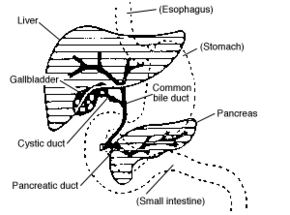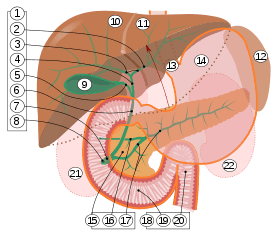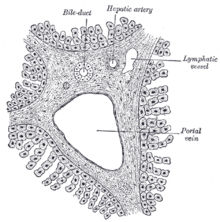Bile duct
A bile duct is any of a number of long tube-like structures that carry bile, and is present in most vertebrates.
| Bile duct | |
|---|---|
 Digestive system diagram showing the bile duct | |
 ERCP image showing the biliary tree and the main pancreatic duct. | |
| Details | |
| Identifiers | |
| Latin | ductus biliaris |
| MeSH | D001652 |
| TA | A05.8.02.013 A05.8.01.062 A05.8.01.065 |
| FMA | 9706 |
| Anatomical terminology | |

9. Gallbladder, 10–11. Right and left lobes of liver. 12. Spleen.
13. Esophagus. 14. Stomach. 15. Pancreas: 16. Accessory pancreatic duct, 17. Pancreatic duct.
18. Small intestine: 19. Duodenum, 20. Jejunum
21–22. Right and left kidneys.
The front border of the liver has been lifted up (brown arrow).[1]
Bile, required for the digestion of food, is secreted by the liver into passages that carry bile toward the hepatic duct, which joins with the cystic duct (carrying bile to and from the gallbladder) to form the common bile duct, which opens into the intestine.
Structure
The top half of the common bile duct is associated with the liver, while the bottom half of the common bile duct is associated with the pancreas, through which it passes on its way to the intestine. It opens into the part of the intestine called the duodenum via the ampulla of Vater.
Segments
The biliary tree (see below) is the whole network of various sized ducts branching through the liver.
The path is as follows: Bile canaliculi → Canals of Hering → interlobular bile ducts → intrahepatic bile ducts → left and right hepatic ducts merge to form → common hepatic duct exits liver and joins → cystic duct (from gall bladder) forming → common bile duct → joins with pancreatic duct → forming ampulla of Vater → enters duodenum.
Nerve supply
Inflation of a balloon in the bile duct causes, through the vagus nerve, activation of the brain stem and the insular cortex, prefrontal cortex, and somatosensory cortex.[2]
Clinical significance
Blockage
Blockage or obstruction of the bile duct by gallstones, scarring from injury, or cancer prevents the bile from being transported to the intestine and the active ingredient in the bile (bilirubin) instead accumulates in the blood. This condition results in jaundice, where the skin and eyes become yellow from the bilirubin in the blood. This condition also causes severe itchiness from the bilirubin deposited in the tissues. In certain types of jaundice, the urine will be noticeably darker, and the stools will be much paler than usual. This is caused by the bilirubin all going to the bloodstream and being filtered into the urine by the kidneys, instead of some being lost in the stools through the ampulla of Vater.
Jaundice
Jaundice is commonly caused by conditions such as pancreatic cancer, which causes blockage of the bile duct passing through the cancerous portion of the pancreas; cholangiocarcinoma, cancer of the bile ducts; blockage by a stone in patients with gallstones; and from scarring after injury to the bile duct during gallbladder removal.
Drainage
Biliary drainage is performed with a tube or catheter (called a biliary drain, biliary stent or biliary catheter) by a surgeon or, commonly, an interventional radiologist.[3] It can be used to relieve a blockage in the bile duct, either permanently or as a temporary solution before definite treatment such as surgery. The drain can be placed percutaneously through the liver, with the procedure then being called percutaneous transhepatic biliary drainage (PTBD).[4] This can additionally be performed as part of a percutaneous transhepatic cholangiography, then a form of interventional radiology. A biliary drain can also be used to take bile samples for diagnostic workup or disease monitoring, as well as providing a route of administration for medical substances.
A surgically created passage between the common bile duct and the jejunum in a procedure called a choledochojejunostomy, can be carried out to relieve the symptoms of biliary obstruction.
In infants with biliary atresia, hepatoportoenterostomy is an alternative method of providing bile drainage.
Cholangiocarcinoma
Cholangiocarcinoma or bile duct cancer is a form of cancer that is composed of mutated epithelial cells (or cells showing characteristics of epithelial differentiation) that originate in the bile ducts. Cholangiocarcinoma is considered to be an incurable and rapidly lethal cancer unless both the primary tumor and any metastases can be fully removed by surgery. No potentially curative treatment exists except surgery, but most people have advanced stage disease at presentation and are inoperable at the time of diagnosis.
Injury
In cholecystectomy there is a slight risk (0.3–0.5%) of injury of the bile ducts, most commonly of the common bile duct.[5] This complication can range from mild forms, which are easy to address during the operation, to more severe forms.[5] If not addressed such injury can be debilitating and lead to considerable morbidity.[5] Such injury can be prevented by routinely using X-ray investigation of the bile ducts (intraoperative cholangiography (IOC)).[5]
Additional images
 3D Printed biliary system.
3D Printed biliary system. Section across portal canal of pig. ×250.
Section across portal canal of pig. ×250. An intraoperative cholangiogram, which is an X-Ray of the bile ducts during a laprascopic cholecystectomy.
An intraoperative cholangiogram, which is an X-Ray of the bile ducts during a laprascopic cholecystectomy.- Bile duct.Deep dissection.Anterior view.
References
- Standring S, Borley NR, eds. (2008). Gray's anatomy : the anatomical basis of clinical practice. Brown JL, Moore LA (40th ed.). London: Churchill Livingstone. pp. 1163, 1177, 1185–6. ISBN 978-0-8089-2371-8.
- Sai, JK; Suyama, M; Kubokawa, Y; Matsumura, Y; Inami, K; Watanabe, S; Kirino, E (2010). "Identification of cerebral response to balloon distention of the bile duct" (PDF). World J Gastroenterol. 16 (14): 1772–5. doi:10.3748/wjg.v16.i14.1772. PMC 2852827. PMID 20380011.
- Biliary Drain Archived 2011-08-07 at the Wayback Machine Patient information from The Ohio State University Medical Center. Retrieved May 2011
- Kuhn, J. P.; Busemann, A.; Lerch, M. M.; Heidecke, C. D.; Hosten, N.; Puls, R. (2010). "Percutaneous Biliary Drainage in Patients with Nondilated Intrahepatic Bile Ducts Compared with Patients with Dilated Intrahepatic Bile Ducts". American Journal of Roentgenology. 195 (4): 851–857. doi:10.2214/AJR.09.3461. PMID 20858809.
- "Intraoperative cholangiography in cholecystectomy". www.sbu.se. Swedish Agency for Health Technology Assessment and Assessment of Social Services (SBU). 2018-08-17. Retrieved 2019-09-02.
External links
| Wikimedia Commons has media related to Bile duct. |
- The Cholangiocarcinoma Foundation
- The Johns Hopkins Gall Bladder & Bile Duct Cancer Web page
- Bile+Ducts at the US National Library of Medicine Medical Subject Headings (MeSH)